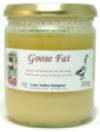Goose Fat
Information about Goose Fat plus Recipes
Â
|
Ingredient
of the
MonthÂ
|
Scroll
down for Recipe Ideas
|
December
2009 |
Â
Click
here for more Ingredients
Â
Â
 As the name implies, goose fat comes from geese which are notoriously rich and
fatty birds. As the name implies, goose fat comes from geese which are notoriously rich and
fatty birds.
Â
However, using goose fat in cooking isn't as unhealthy as it may
first sound and in many cases, it's preferable to other fats such as butter.
Â
Â
Use of Goose Fat through the ages
Â
There is evidence dating back to 2500 BC showing that the ancient Egyptians kept
geese for food, a practice which gradually spread to the Mediterranean and by
500AD the keeping of geese had become an established practice of European
peasants' lives mainly because they cost little to keep, grew quickly and
produced meat and lots of spare fat, the consumption of which was an
important feature to (a) keeping warm in the days before central heating and (b)
as a good source of energy to sustain peasants who did hard manual labour. It
could even have been used in lamps much like tallow.
Â
By the 18th Century, large flocks of geese were being reared in the UKÂ for
commercial purposes, providing meat, fat, feathers and ink quills.
Â
Although the French have always used goose fat for culinary purposes,
particularly in dishes such as Confit and Cassoulet, during the early 20th
century in England, goose fat became better known for medicinal uses including
being rubbed on the chest as a remedy for colds, as a cure for sore
throats and as a relief for chapped hands.
However, in 1958 Elizabeth David flagged it as a culinary ingredient when
she wrote an article in House & Garden in which she described how to cook a
Goose and save the fat for frying. Even then, it was only towards the very
end of the 20th century that its popularity rose sharply in the UK, mainly
due to some celebrity chef or other plugging it. Thankfully, today it is
widely available in supermarkets and many butchers.
Nutritional Values of Goose Fat
As with all
fats, goose fat is relatively high in calories at around 115 calories per
tablespoon, however it contains fewer saturated fats than butter or lard, is
higher in monounsaturated and polyunsaturated fats and is also rich in
Oleic acid (a monounsaturated fatty acid) which is believed to lower blood
cholesterol levels.Â
Obtaining, Buying and storing Goose Fat
In order to make your own goose fat you will need to roast a goose. As mentioned
earlier, geese are very fatty birds, so even one goose will provide you with
plenty of goose fat for later use.
Â
Goose fat has a very long shelf-life of 12 months or more in tins or if kept in
sterilised jars and refrigerated.
Â
You'll find goose fat in stores in tins or most often in jars in the chilled foods
cabinet, possibly near to butters and spreads. Although it may seem a little
expensive, it is well worth buying because, so long as it's relatively clear and
free of bits, after use, it can be poured back into the jar,
refrigerated and re-used. It will keep for 2-3 months - plenty of time to
experiment with it.
Â
Â
|

 As the name implies, goose fat comes from geese which are notoriously rich and
fatty birds.
As the name implies, goose fat comes from geese which are notoriously rich and
fatty birds.